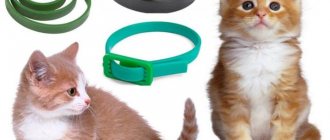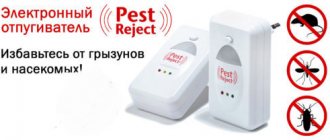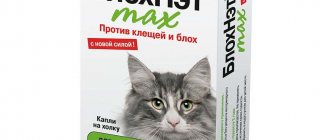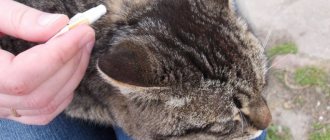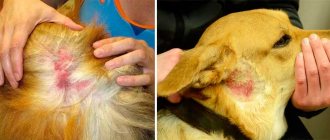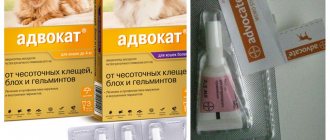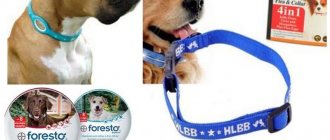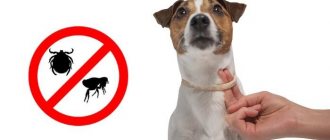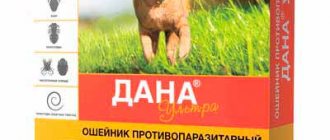Lately, you can often see a cat wearing a flea collar walking down the street. This stylish accessory has a very specific function - protecting the animal from external parasites. However, pet owners do not always have the correct understanding of how a flea collar for cats works. Awareness of this issue will allow you to avoid a lot of mistakes when using this means of protection.
Operating principle
Flea collars for cats
A flea collar for cats is one of the most popular forms of using antiparasitic drugs. The soft rubberized material can be impregnated with repellent or insecticide.
The repellent repels harmful insects, thereby protecting the animal from their attack. As a rule, essential oils have an unpleasant odor for fleas. The instructions for each protective product indicate how long the repellent-based flea collar lasts. As a rule, after 2 - 3 months it needs to be replaced with a new one. Such a device is not a remedy for flea infestation, but only prevents them from attacking the animal.
If the collar is impregnated with an insecticide (organophosphates, carbamate poisons), then the principle of its action is somewhat different. Accumulating in the skin of the animal, the insecticide not only repels blood-sucking insects with its smell, but also kills them if they accidentally bite. Such an accessory can already be used not only to prevent flea and tick attacks, but also as a remedy for the presence of parasites on an animal.
Attention! Cases have been identified where a cat was poisoned by a flea collar. Although they are isolated, they still occur. However, such a result is possible under the following circumstances: the animal’s individual intolerance to specific components of the drug or the combination of a collar soaked in an insecticide with strong drops.
Contraindications
Contraindications to the use of anti-flea accessories are:
- weakened health of the cat, weak immunity;
- old age of the cat;
- the presence of serious illnesses;
- young age. A kitten under two months of age is prohibited from wearing the product;
- pregnancy. For cats bearing offspring, biomodels have been developed that do not contain poisons or toxins.
Pros and cons
An antiparasitic collar, like any other insecticidal agent, has its positive and negative sides. The undoubted advantages of flea protective agents of this type include the following points:
- Does not require hygiene procedures (washing, combing, etc.), as is the case with the use of shampoos and sprays.
- Universal collars repel not only cat fleas, but also more dangerous parasites - ticks. It is precisely these means of protection that owners often resort to when they take their pets out of town, to the countryside, or into nature.
- Effective protection for a long time. How long to wear a flea collar for cats depends on the type of impregnation. Repellent polypropylene tapes protect your pet for 2 - 3 months. If impregnation with an insecticide was used, the validity period can be up to 6 months.
- The risk of overdose is reduced, since the collar is factory impregnated with a toxic substance in a dose that is non-toxic to the animal.
- A wide selection and affordable prices play an important role in choosing an antiparasitic product.
- A cat walking down the street wearing an accessory is not only protected from attacks by parasites, but also does not look like a stray animal.
“Clandestine” flea collars are used only for prevention.
However, despite the obvious advantages and positive aspects, anti-parasitic straps also have a number of disadvantages:
- Repellent tapes are intended for prevention only. For example, the Celandine flea collar for cats already infested with blood-sucking insects is ineffective. The animal should be treated with shampoo, drops, anti-flea sprays and only then provided with a collar to prevent re-infestation.
- The validity period of an antiparasitic agent in the form of a tape is usually less than that specified by the manufacturer. This is due to the operating conditions of the product.
- The collar is contraindicated for kittens under 2 months.
- The action of the anti-flea accessory is directed only against mature fleas. This form of insecticide does not affect eggs, larvae, and pupae.
- For hyperactive animals, it is better not to use a collar, but to resort to other means of protection (for example, drops), since when actively climbing trees, the cat can get caught and get injured.
- Whether a flea collar helps cats can only be judged after at least 5 days have passed from the date of use. You should not expect instant death of insects.
When choosing an anti-parasitic collar as protection against cat fleas and ticks, you should weigh the pros and cons. In this case, it is necessary to take into account the physiological state of the pet, its lifestyle, and level of health. You should also consider the potential risk of infestation not only from cat fleas, but also from more dangerous parasites.
Possible negative consequences
As one of the forms of using an insecticide against fleas, an anti-flea accessory can cause the following troubles:
- Allergy to flea collar . This phenomenon is not uncommon when using an antiparasitic accessory. Allergies most often occur when permethrin and tetrachlorvinphos are used as impregnations. The reaction may manifest itself in the form of itchy skin, sneezing, and watery eyes. In acute cases, convulsions, loss of coordination of movement, depression, and loss of consciousness are possible. Allergy symptoms usually appear 1 to 2 hours after use.
- Poisoning . Symptoms of poisoning by insecticides contained in the collar are similar to those of an allergic reaction. But in case of intoxication, the first signs appear 5 - 6 hours after using an accessory soaked in chemicals, and in case of allergies - in the first hour.
It is impossible to answer unequivocally the question of whether a flea collar is harmful. Allergic manifestations, poisoning and chronic intoxication certainly have a negative impact on the pet’s health. It is also recommended to periodically check the condition of the pet’s skin during the entire period of use of the protective device.
Criterias of choice
To decide whether to buy a flea collar or anti-flea drops for your pet, you need to consider the following criteria:
- pet's age and weight. Manufacturers provide instructions that describe the rules for using insecticidal substances. Insect collars are allowed for animals over two months of age. The tapes have different lengths. You need to select it taking into account the volume of your pet’s neck. They are produced in lengths from thirty-five to forty centimeters. The tapes are regulated by a special fixing device. Do not tighten the collar too tightly. The distance between the neck and the tape should be at least two centimeters;
- absence of any contraindications for use. If the owner does not have such information when purchasing drops, then a test must first be performed. A small amount of the solution is dripped onto the animal’s withers, and it is observed whether the body reacts to the insecticide. This criterion also applies to collars. When the animal wears it for some time, you need to check its skin in the neck area. If allergic reactions appear there, or the hair begins to fall out, select a ribbon from another manufacturer;
- the effectiveness of the drugs, taking into account the climatic conditions in which the pet lives.
Safety rules for putting on and wearing
Many pet owners mistakenly believe that there are no special rules on how to put a collar on a cat to protect it from fleas. However, for effectiveness and safety, you should listen to the recommendations of manufacturers and veterinary specialists:
- Use only products intended for this type of animal (do not use products intended for dogs on cats).
- Do not cut the product into pieces; it is intended for one animal, taking into account its weight.
- The collar should be secured to the pet so that it does not dangle around the neck, but does not squeeze too much. It should be remembered that in different poses the diameter of the pet’s neck is different. Manufacturers recommend making a gap of one centimeter between the strap and the body.
- If the protective device is periodically removed, it should be stored in a closed plastic bag. This will prevent a decrease in the preventive effect ahead of time.
- Before putting on a flea collar for cats, the instructions should be carefully studied for combination with other insecticides. As a rule, it is strictly forbidden to use a collar in combination with other flea control products. This can lead to an overdose and poisoning of your pet with insecticides. If the animal has been treated with shampoo, injections, tablets, sprays, the collar can only be put on 3 - 5 days after the parasites have been destroyed.
We recommend reading the article about where domestic cats get fleas. From it you will learn about possible routes of infection, signs and symptoms of a pet having fleas, and the dangers that fleas pose to humans and cats.
Precautionary measures
Using a collar requires the following precautions:
- If the tape is ineffective and your pet exhibits unpleasant symptoms, change the brand . Perhaps the model is not suitable for your pet.
- Buy only those products whose effects have been tested by your friends . When choosing, you should not focus on low cost.
- You cannot combine the tape with other antiparasitic agents ; this can lead to hair loss, dermatitis, and allergies in your pet.
- Make sure that your pet does not chew the end of the tape , as this can lead to poisoning. In this case, conscientious manufacturers indicate the antidote substance in the instructions.
Selecting the best options among those offered
A wide selection of antiparasitic devices on the pet products market is presented by both foreign and domestic manufacturers:
- "Bars" . A domestically produced protective agent based on fipronil provides a preventive effect for 4 months. Can be used from 2 months of age. Contraindications: pregnancy, feeding. It is not recommended for use in sick and weakened animals.
- "Befar" . A flea and tick collar for cats from a European company provides maximum protection 5 days after use and remains effective for 5 months. Not recommended for pregnant, lactating cats and young animals under 6 months of age.
- "Bolfo " The active ingredient of the product is propoxur, which has a universal insecticidal effect. The collar can be used on productive cats after consultation with a veterinarian.
- “Clandestine” . Collar for cats and dogs of domestic production. The active ingredient is permethrin, which destroys fleas, lice-eaters, and ixodid ticks. The protective device is not recommended for pregnant or lactating females. Can be used for kittens from 4 months of age.
- “Dana-ultra” . A combined action product that is effective against fleas and ticks. Used from 2 months of age, not recommended for productive animals.
Is it possible to do it yourself?
Many cat owners are interested in whether it is possible to make a flea collar with their own hands. Does it help? Experts still do not advise experimenting in this case and spraying insecticides on ordinary collars. An animal can easily get toxic skin damage.
Dermatitis or an allergic reaction will soon appear. During production at the plant, a certain volume of an insecticidal-acaricidal substance is sprayed onto a polymer tape. This allows the product to gradually release and protect the pet. Unfortunately, it is impossible to achieve this effect at home.
Can the collar be used on a pregnant cat?
The Bolfo flea collar can be used on pregnant cats
Despite the widespread advertising and popularity of the protective accessory, veterinarians are often asked questions about its effect on the animal’s health, side effects, and use in a particular physiological condition. And some of the most popular ones are about wearing while expecting offspring.
- Is it possible to put a flea collar on a nursing cat? The use of this type of protection for a nursing female is not recommended by both manufacturers and veterinary specialists. The insecticide used to impregnate the tape has a long-lasting effect, which can cause severe poisoning in small kittens and lead to the death of offspring. To treat a nursing cat against blood-sucking insects, there are specially developed preparations, for example, “Frontline” drops.
- Is there a flea collar available for sale for a pregnant cat? Almost all insecticide-impregnated tapes are not recommended for pregnant cats. Veterinary specialists prefer collars based on essential oils to protect an animal in an interesting position. They are less dangerous in terms of intoxication, but will not protect against allergic manifestations.
- Insecticidal tape “Bolfo” can be used for pregnant pets, but only after prior consultation with a veterinarian who will assess the health of the expectant mother.
The question of which flea collar is best is difficult to answer even for a veterinarian with extensive experience. In any case, you need to choose products from well-known companies that are responsible for their pet products, buy protective equipment from trusted veterinary pharmacies, and do not skimp on cheap Chinese counterfeits.
Similar articles
- How fleas reproduce in cats: how many of them live on...
From it you will learn about the signs of a parasite in a pet, effective means for getting rid of fleas, such as shampoos, drops on the withers, flea collars, sprays. … For cats. Flea dermatitis in a cat. Read more - How to remove fleas from a cat, how to get rid of them (wash, anoint...)
We recommend reading the article about how a flea collar works. From it you will learn about the principles of operation of flea collars for cats, types of devices, and the possible negative consequences of their use... Read more
- How to wash a cat if he is afraid, how to do it...
The most popular are regular liquid shampoos for washing domestic cats. ... Since there are going to be water procedures, it’s a good idea to figure out how to wash your cat for fleas in order to combine both pleasant and useful things. Read more
- Where does a domestic cat get fleas: what they look like, what...
How does a flea collar for cats work and is it real... How to treat ear mites in a cat: what is it, where does it come from... Why does a cat's hair fall out, it comes out in clumps... Read more
- A cat has tubercles on its ears: how to treat it, what to do if...
There are quite a lot of parasites that terrorize pets. If a cat has bumps on its ears, how to treat the beauty? ... We recommend reading the article about how a flea collar works. Read more
How it works
The collar is a ribbon impregnated with special repellents. It is effective against many ectoparasites, including ticks and lice eaters. Most often, the composition of the impregnation is represented by two active components - diazonin and permethrin. The action of insecticides is identical: fleas receive a dose of poison and die from paralysis.
Some cat collars contain only natural ingredients. Most often it is an extract of margosa or the Neem tree. Such biocollars are quite effective and can be worn by kittens as young as ten months old. The development of allergies is practically excluded.
The validity period depends on the manufacturer. The average period of effectiveness is two months. Although some anti-flea tapes can last as long as six months.
